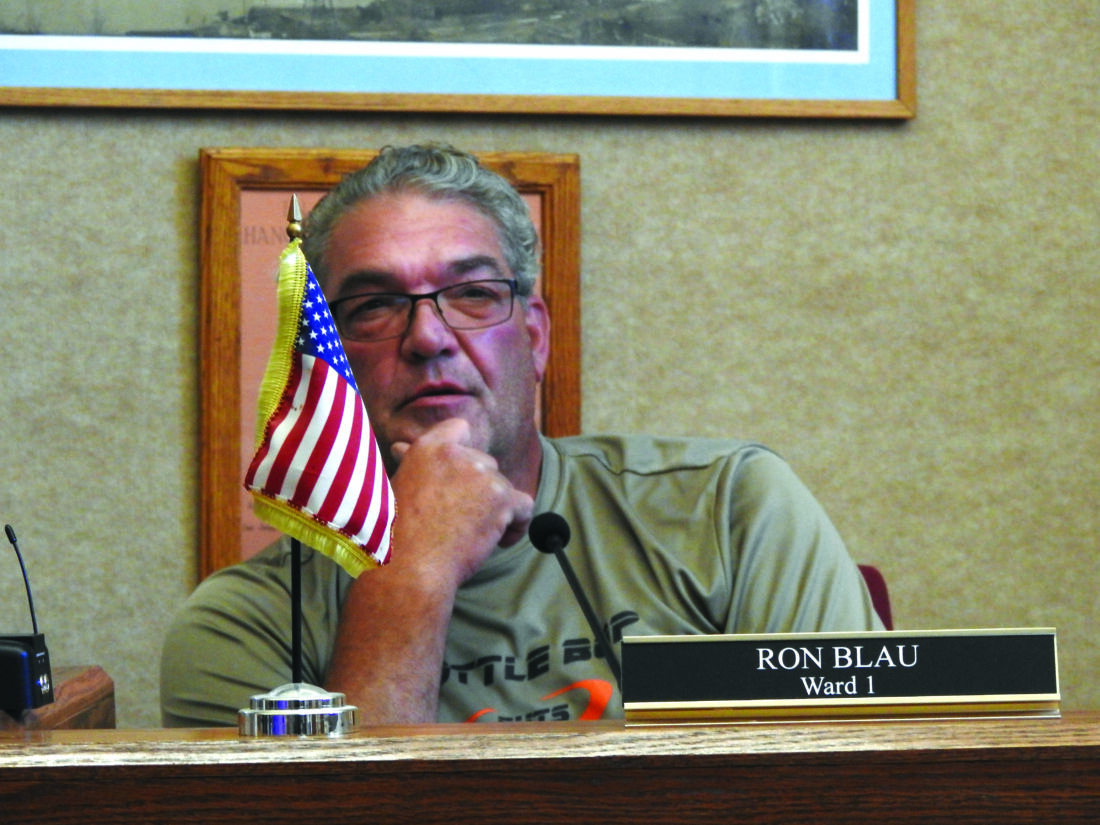Hancock updates zoning ordinance
- Garrett Neese/Daily Mining Gazette Hancock resident Shannon Perkins speaks during a public hearing on the city’s proposed zoning ordinance Wednesday night. Perkins criticized the proposed ordinance, as well as a lack of direct notice from the city during the process of creating it.
- Garrett Neese/Daily Mining Gazette Hancock Councilor Ron Blau talks during Wednesday’s special meeting on the proposed zoning ordinance. Blau voted in favor of the ordinance, which passed 5-2.

Garrett Neese/Daily Mining Gazette Hancock resident Shannon Perkins speaks during a public hearing on the city’s proposed zoning ordinance Wednesday night. Perkins criticized the proposed ordinance, as well as a lack of direct notice from the city during the process of creating it.
HANCOCK — After more than two hours of comments from council members and more than a dozen members of the public, the Hancock City Council approved its new zoning ordinance by a 5-2 vote at a special meeting Wednesday night.
The top-to-bottom rewrite is the first overhaul of the city’s zoning since the last ordinance was passed in 1974, City manager Mary Babcock said. The 20-month process included more than 25 meetings, including meetings with stakeholder groups.
Council members who backed the new ordinance stressed that the new one will be a “living document,” and more frequently updated to match city needs.
Councilor Lisa McKenzie recalled first trying to get an ordinance committee together to look at zoning when first elected to the council in 2000.
“I know that this council, and this planning commission, is dedicated because of our master plan to continuously update this ordinance,” she said. “We cannot let ordinances go 50 years, and it has to be looked at. I agree, it’s not perfect … we could spend two or three more years at it, and it still won’t be perfect.”

Garrett Neese/Daily Mining Gazette Hancock Councilor Ron Blau talks during Wednesday’s special meeting on the proposed zoning ordinance. Blau voted in favor of the ordinance, which passed 5-2.
The new ordinance was put together in accordance with the priorities in the city’s 2018 master plan, itself a requirement under the state’s 2006 Zoning Enabling Act. The process for updating the five-year master plan will start soon, Babcock said.
“Then we’re going to be looking at ‘this is our zoning, how does this reflect our master plan,’ and we’re going to start the review process and make sure those plans are intertwined with one another … it gives us guidance to the city for the next five years,” she said.
Having an updated zoning ordinance is also an important part of being certified as a state Redevelopment Ready Community, which the city is pursuing. That could get the city additional technical assistance, as well as qualify the city for various grants.
“There recently were two grants that were put out that I know that require a community to be redevelopment ready certified,” she said. “So that is money that we do not have the ability to reach out and obtain to help us do some revitalization work downtown.”
One goal mentioned in the city’s master plan, the new Shoreline Mixed-Use district, was one of the most common items mentioned by residents. The district combines areas around the waterfront previously zoned as conservancy, industrial or business. The zoning ordinance states the city is hoping for commercial and residential development, as well as recreational uses on a neighborhood scale.
Jennifer Becker thought some areas should remain under conservancy zoning. She pointed to Marquette, which she said has seen reduced public access and fewer sight lines to the lake after new development over the past decade.
“You have the opportunity to make this a really unique place, the jewel of the Keweenaw, not Everyplace, U.S.A.,” she said.
Others worried about a business district near the Sylvan Estates neighborhood.
Many of the residents who spoke said the council should hold off on a decision until after more public hearings. Many said they had not followed news coverage of previous hearings, and suggested ways the city could proactively inform people, such as mailers or soliciting opinions via the city’s Facebook page.
“It’s an electronic society now,” said Holly Matson. “We all need to just grasp the fact that this is how people get their information.”
Councilor John Haeussler encouraged residents to sign up for the city’s email newsletter, which includes links to notices and agendas for upcoming meetings.
Some residents who spoke backed approval of the plan. Frank Fiala told the council tabling the vote would just lead to more delays.
“Based on past experience, this thing will go on and on and on and on and you’ll never have an ordinance that you need,” he said. “If you pass the ordinance and then come back and hold public meetings, discussion points in terms of addressing the concerns of some of the people that have spoken tonight you’ll have the opportunity to amend that and make this document much much better.”
The council voted 5-2 to approve the plan, with Councilors Richard Freeman and Whitney Warstler dissenting.
Freeman pointed out the number of residents who had issues with the draft ordinance.
“I just think we’re trying to buy a car that has three wheels,” he said. “I understand if we table it tonight … it’s going to be another 30 days. We’ve already spent 20 months. Why are we trying to pass something that already has problems in it?”
He cited issues such as being unable to hook a camper up to his own electric power for more than 24 hours. Councilor John Haeussler said if Freeman brought that amendment to the council, he would back him “100%.” However, he said, that wouldn’t be enough to stop him from voting for the ordinance.
“This is not the only ordinance that has been 50 years out of date,” Haeussler said. “We have a backlog of things that need to be done. And we’re trying to continue to bite off what we feel we can chew and try to move forward.”
Warstler thought the council should take more time to address criticisms before passing the ordinance. While councilors had said they were willing to update the ordinance, new council members who come on in November might feel differently, she said.
“We keep hearing the same things, and I think it would be a disservice to pass this without reevaluating those,” she said.
Mayor Pro Tempore Kurt Rickard said while the zoning ordinance doesn’t have everything he would want, it would provide a good starting point. Rickard, who also sits on the city planning commission, said it would start taking up the waterfront and Sylvan Estates issues at its next meeting.
“I want to bring everybody that’s concerned about the shoreline together, and let’s figure out what we really want down there,” he said. “I think it’s a good first pass at what we want to see. We want public access — a lot more public access — and we want people to be able to see and have access to the lake, we want it to look good from the other side of the lake.”
Haeussler suggested extending the R-1 district further out around the Sylvan Estates neighborhood, which would still allow development along Campus Drive but reassure residents who had concerns about businesses popping up adjacent to them.
The new ordinance will take effect in 30 days.







